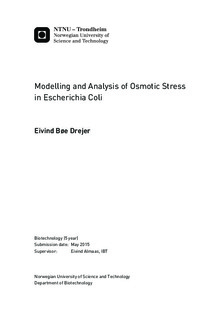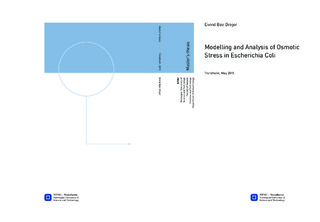| dc.description.abstract | Microorganisms are known to be affected by stresses such as osmotic stress
by reducing their growth rate. Understanding the mechanisms behind
this are important, as it can aid in the development of new methods of con-
serving food a common source of pathogen infection for humans.
One of the most common pathogenic infections for humans is Escherichia
coli (E. coli). In 2014, the Center for Disease Control and Prevention in
the USA reported two outbreaks of pathogenic E. coli, both transmitted
through food. In developing countries, acute diarrhea is the second most
common cause of infant death, and infection by E. coli is one of the most
common sources. In order to effectively combat E. coli infection in hu-
mans, it is important that accurate methods for predicting the organism s
response to external stresses are developed.
The goal of this master thesis was to investigate the metabolism of E. coli
under osmotic stress. In order to accomplish this, the project was set up
as a collaboration with the Institute for Food Research (IFR) in Norwich,
United Kingdom. Through collaboration with the Computational Micro-
biology Research Group at IFR, gene expression data for E. coli growing
under different states of osmotic stress was collected and analyzed using
metabolic modelling.
The complex nature of osmotic stress required the development of a new
method, dubbed Metabolic Flux Distribution by Translational Efficiency
and Enzyme Kinetics (MUTE). MUTE is able to predict changes in metabolic
flux based on gene expression data, translation efficiencies and enzyme ki-
netics. MUTE was shown to increase the sensitivity to expression data
compared to other methods such as Metabolic Adjustment by Differential
Expression (MADE), resulting in new predictions on metabolic changes
during osmotic stress in E. coli. Another novelty of MUTE is its level of
detail, where enzyme concentration predictions are levels reported by em-
pirical data. | |

